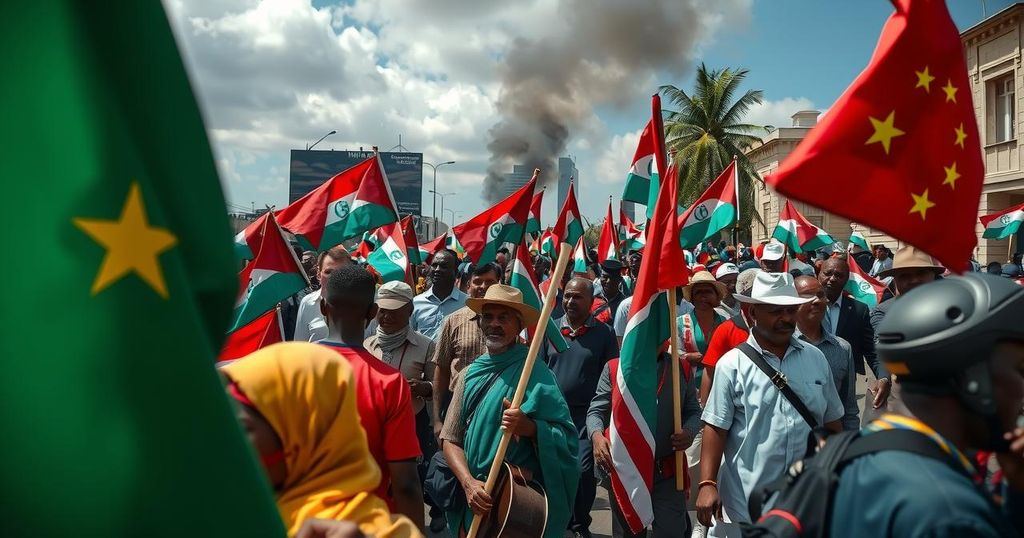This article outlines the tumultuous history of Somalia from the era of colonial partition through resistance movements led by Sheikh Maxamed Cabdulle Xasan, known as the Mad Mullah, and the subsequent establishment of the Somali Republic. It highlights the complexities of colonial legacies, foreign policy disputes with Ethiopia and Kenya, and the military coup that shaped the nation’s governance under Siad Barre. Throughout, the influence of clan allegiances and the drive for national unity are emphasized as key factors in Somalia’s journey toward independence and beyond.
Prior to the partition of Africa, British Somaliland faced substantial challenges, notably from a religious uprising led by Sheikh Maxamed Cabdulle Xasan, who became known as the Mad Mullah. Initially, he gained the respect of both the British authorities and his followers, being admired for his religious knowledge and capabilities as a mediator. However, in 1899, conflicts arose between him, the Christian missionary efforts, and the colonial administration, which, alongside rising European and Ethiopian territorial ambitions, ignited a significant Somali rebellion. Despite not claiming the title of mahdi, Maxamed declared himself a sayyid, garnering a group of followers known as the dervishes. His strategy combined traditional Somali clan politics with a call for collective Muslim resistance against colonialism. Due to the influx of arms that became accessible through Djibouti, the dervishes successfully resisted multiple military campaigns by British and Italian forces up through 1904, leading to British withdrawal to coastal areas by 1910 and a temporary success for the sayyid. Nonetheless, renewed military efforts involving advanced weaponry culminated in an offensive against the dervishes in 1920, leading to their ultimate defeat. In contrast, Italian Somaliland entered a different colonial trajectory, facing less disruption due to the sayyid’s rebellion. The first fascist governor was appointed in 1923, marking a period of active development, leading to the incorporation of Jubaland and establishing fruitful plantations in the region. However, territorial disputes with Ethiopia remained, leading to conflicts such as the Welwel incident in 1934. Following World War II, the dynamics shifted as British Somaliland was recaptured alongside Italian Somalia, resulting in unification and independence within a decade. On June 26, 1960, the British protectorate achieved independence, followed by the Italian territory on July 1, leading to the formation of the Somali Republic. The integration faced immediate challenges, particularly due to clan politics influencing governance. Somalia’s foreign policy initially focused on Somali unification conducive to neighboring populations, though tensions erupted leading to conflicts over territories with Ethiopia and Kenya. The military coup of October 21, 1969, brought Mohamed Siad Barre to power, who promoted a regime based on ‘Scientific Socialism’. This approach aimed at addressing poverty and ignorance, shifting foreign alliances toward socialist countries while suppressing clan affiliations domestically. Despite initial successes, Barre’s regime faced difficulties, particularly following losses during the Ogaden War against Ethiopia from 1977 to 1978, resulting in an influx of refugees. Ultimately, the interplay of internal politics, colonial legacies, and external pressures significantly shaped the trajectory of Somalia throughout the 20th century.
The history of Somalia’s colonial experience is marked by significant upheavals and resistance efforts, especially the rebellion against British administration led by the Mad Mullah, Sheikh Maxamed Cabdulle Xasan. His uprising not only reflects the tensions introduced by European colonialism but also showcases the interplay between religious fervor and nationalism. Following the eventual defeat of the dervishes, the political landscape of Somalia evolved, particularly during and after World War II, shaping the ultimate path towards independence and the establishment of the Somali Republic. The actions of various colonial powers shaped not only regional conflicts but also provided the impetus for the eventual military governance of Bourreau, reflecting deeper patterns of resistance and political ideology. Understanding these historical contexts is crucial for grasping the complexities of Somalia’s modern socio-political challenges.
In conclusion, the trajectory of Somalia’s colonial history, marked by the resistance led by Maxamed Cabdulle Xasan, the varying degrees of disruption in British versus Italian Somaliland, and the complexities arising during the transition to independence, highlight the lasting impacts of colonialism. The subsequent struggles for national unity, the rise of military governance under Mohamed Siad Barre, and the dynamics of allegiance amidst clan politics, remain critical in comprehending the contemporary landscape of Somalia. Ultimately, these events reveal interconnections between historical legacies and modern-day challenges.
Original Source: www.britannica.com







